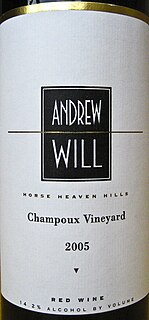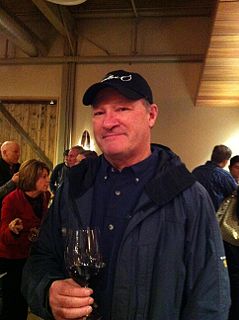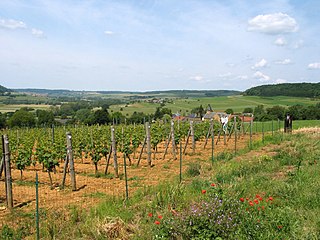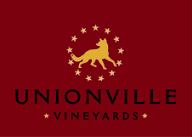
A vineyard designated wine is a wine produced from the product of a single vineyard with that vineyard's name appearing on the wine label.

Wine is an alcoholic drink made from fermented grapes. Yeast consumes the sugar in the grapes and converts it to ethanol, carbon dioxide, and heat. Different varieties of grapes and strains of yeasts produce different styles of wine. These variations result from the complex interactions between the biochemical development of the grape, the reactions involved in fermentation, the terroir, and the production process. Many countries enact legal appellations intended to define styles and qualities of wine. These typically restrict the geographical origin and permitted varieties of grapes, as well as other aspects of wine production. Wines not made from grapes include rice wine and fruit wines such as plum, cherry, pomegranate, currant and elderberry.

A vineyard is a plantation of grape-bearing vines, grown mainly for winemaking, but also raisins, table grapes and non-alcoholic grape juice. The science, practice and study of vineyard production is known as viticulture.

Wine labels are important sources of information for consumers since they tell the type and origin of the wine. The label is often the only resource a buyer has for evaluating the wine before purchasing it. Certain information is ordinarily included in the wine label, such as the country of origin, quality, type of wine, alcoholic degree, producer, bottler, or importer. In addition to these national labeling requirements producers may include their web site address and a QR Code with vintage specific information.
Throughout the history of winemaking and viticulture, the differences in quality between one plot of land and another have been observed with the boundaries of these vineyard generally well demarcated. In Burgundy, the vineyards of the area are classified with the highest quality vineyards receiving the ranking of Grand cru. [1] The names of these vineyards, such as Montrachet, will often appear on the wine label of Burgundy wines in bolder, more prominent print than even the name of the producer. [2]

Viticulture or winegrowing is the cultivation and harvesting of grapes. It is a branch of the science of horticulture. While the native territory of Vitis vinifera, the common grape vine, ranges from Western Europe to the Persian shores of the Caspian Sea, the vine has demonstrated high levels of adaptability to new environments. For this reason, viticulture can be found on every continent except Antarctica.

Montrachet is an Appellation d'origine contrôlée (AOC) and Grand Cru vineyard for white wine made of Chardonnay in the Côte de Beaune subregion of Burgundy. It straddles the border between the two communes of Chassagne-Montrachet and Puligny-Montrachet and produces what many consider to be the greatest dry white wine in the world. It is surrounded by four other Grand Cru vineyards all having "Montrachet" as part of their names. Montrachet itself is generally considered superior to its four Grand Cru neighbours, and this is reflected in its higher price.
In the United States, the appearance of vineyards name on wine labels is a relatively recent phenomenon with one of the first vineyard designated premium wines in California being the 1966 vintage Heitz Martha's Vineyard Cabernet Sauvignon. [3] Later examples include the 1975 Robert Young Vineyard Chardonnay from the Sonoma wine estate of Chateau St. Jean. [4] [5] On the East Coast, Unionville Vineyards produces single vineyard wines, primarily Chardonnay. [6] Under US wine laws, if the name of vineyard appears on the label at least 95% of the grapes used to make the wine must come from that vineyard. [7]

Heitz Wine Cellars is a California wine producer located within Napa Valley east of the town of St. Helena. An early modern era Napa Valley presence and pioneering exponent of French oak, the estate enjoys a historical renown with the success of its Martha's Vineyard Cabernet Sauvignon, and has also been described as a "master of Grignolino".

Chardonnay is a green-skinned grape variety used in the production of white wine. The variety originated in the Burgundy wine region of eastern France, but is now grown wherever wine is produced, from England to New Zealand. For new and developing wine regions, growing Chardonnay is seen as a "rite of passage" and an easy entry into the international wine market.
In Washington State, some of the top vineyards appear on vineyard designated wines including Champoux Vineyard and Destiny Ridge Vineyard in the Horse Heaven Hills AVA and Boushey Vineyard in the Yakima Valley AVA. [8]

Champoux Vineyard is a grape growing estate located in the Horse Heaven Hills AVA of Washington State. Grapes grown in the vineyard have been used to produce some of the most critically acclaimed Washington wines with the name Champoux regularly being featured on vineyard designated wines. Paul Gregutt, wine writer for the Seattle Times and Wine Enthusiast, list Champoux as one the "top ten" vineyards in the entire state. Cabernet Sauvignon grapes from Champoux vineyards were featured in the consecutive 100 point Robert Parker rated wines from Quilceda Creek Vintners for the 2002 and 2003 vintages.

The Horse Heaven Hills AVA is an American Viticultural Area in southeastern Washington, and is part of the larger Columbia Valley AVA. The Horse Heaven Hills AVA borders the Yakima Valley AVA on the north and the Columbia River on the south. Elevations in this AVA range from 200 feet (61 m) above sea level in the south to 1,800 feet (549 m) above sea level at the northern boundary. Grapes planted in the south-facing slopes of the Horse Heaven Hills benefit from strong winds that arrive from the west via the Columbia Gorge, reducing the likelihood of rot and fungal diseases.

Boushey Vineyard is a grape-growing estate located in the Yakima Valley AVA, north of Grandview, Washington. Grapes grown in the vineyard have been used to produce some of the most critically acclaimed Washington wines with the name Boushey regularly being featured on vineyard designated wines. Paul Gregutt, wine writer for the Seattle Times and Wine Enthusiast, list Boushey as one the "top ten" vineyards in the entire state. The vineyard is owned and managed by viticulturist Dick Boushey who was honored in 2002 by the Washington State Wine Commission as Washington's "Grower of the Year" and in 2007 by Wine & Spirits as their "Grower of the Year". After Red Willow Vineyard, which was planted with David Lake and Mike Sauer, Boushey was one of the first Washington wine growers to plant Syrah. Today, Boushey Vineyard is considered by wine experts such as Jon Bonné to be "One of the state's top Syrah spots" with many Washington Syrahs made from Boushey's grape receiving critical acclaim.















